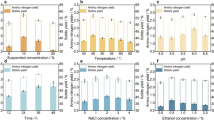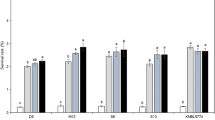Abstract
The effects of variations in cultivation conditions on trehalose concentration and the viability of brewing yeasts following preservation by filter paper or lyophilization methods were evaluated. In case of filter paper preservation, the cultivation period had no affect on yeast viability, while agitation and aeration during cultivation had a positive effect regarding viability of the bottom-fermenting strains, Rh and Frank. For effective preservation, it was necessary to harvest yeast cells from the stationary phase during cultivation. For lyophilization preservation, the yeast strains tested showed a negative effect on viability, independent of strain or cultivation method. No significant correlation was found between trehalose concentration and yeast viability following either filter paper or lyophilization preservation. However, the filter paper preservation method was suitable for both bottom and top brewing yeast strains with regard to feasibility, viability, and maintenance of the yeast’s specific character.
Similar content being viewed by others
References
Kirsop, B. and J. J. S. Snells (1984) Maintenance of Microorganisms. 1st ed., pp. 109–130. Academic Press, London, UK.
Fischer, K. and J. Rahn (2000) Einfluss der Stammkonservierung auf die genetische Satabilitaet von Backhefen. Branntweinwirtschfaft 140: 17–21.
Harrison, M. (1996) Laboratory management of yeast. Ferment. 9: 35–36.
Sips, R. (1998) Quantifizierung und Indentifizierung von Straterkunturen nach morphologischen und genetischen Kriterien. Ph.D. Thesis. Technical University of Berlin, Berlin, Germany.
Brambl, R. and G. A. Marzluf (1996) Regulation of Ttrehalose Metabolism and Its Molecular Biology. pp. 395–414. Springer-Verlag, Berlin, Heidelberg, NY, USA.
Panek, A. D. (1991) Storage carbohydrates. pp. 655–678. In: A. H. Rose and J. S. Harrison (eds). The Yeasts. Vol. 4. 2nd ed., Academic Press, London, UK.
Wackerbauer, K., T. Tayama, M. Fitzner, and S. Kunerth (1997) Zeitgemaesses Management der Anstellhefe. Brauwelt 3: 80–87.
Oh, K. T., C. M. Kang, M. Kubo, and S. Y. Chung (2006) Culture conditions of Psedomonas aeruginosa F722 for biosurfactant production. Biotechnol. Bioprocess Eng. 11: 471–476.
Katayon, S., S. C. Ng, M. M. N. Megat Johari, and L. A. Abdul Ghani (2006) Preservation of coagulation efficiency of Moringa oleifera, a natural coagulant. Bio-technol. Bioprocess Eng. 11: 489–495.
Eleutherio, E. C. A., F. M. Maia, M. D. Pereira, R. Degre, D. Cameron, and A. D. Panek (1997) Induction of desiccation tolerance by osmotic treatment in Saccharomyces uvarum var. carlsbergensis. Can. J. Microbiol. 43: 495–498.
Hounsa, C. G., E. V. Brandt, J. Thevelein, S. Hohmann, and B. A. Prior (1998) Role of trehalose in survival of Saccharomyces cerevisiae under osmotic stress. Microbiology 144: 671–680.
Moon, S. H., J. M. Park, H. Y. Chun, and S. J. Kim (2006) Comparisons of physical properties of bacterial celluloses produced in different culture conditions using saccharified food wastes. Biotechnol. Bioprocess Eng. 11: 26–31.
Rosfarizan, M. and A. B. Ariff (2006) Kinetics of kojic acid fermentation by Aspergillus flavus link S44-1 using sucrose as a carbon source under different pH conditions. Biotechnol. Bioprocess Eng. 11: 72–79.
Hottiger, T., T. Boller, and A. Wiemken (1987) Rapid changes of heat and desiccation tolerance correlated with changes of trehalose content in Saccharomyces cerevisiae cells subjected to temperature shifts. FEBS Lett. 220: 113–115.
Hottiger, T., T. Boller, and A. Wiemken (1989) Correlation of trehalose content and heat resistance in yeast mutants altered in the RAS/adenylate cyclase pathway: is trehalose a thermoprotectant? FEBS Lett. 255: 431–434.
Attfield, P. V. (1987) Trehalose accumulates in Saccharomyces cerevisiae during exposure to agents that induce heat shock response. FEBS Lett. 225: 259–263.
De Virgilio, C., U. Simmen, T. Hottiger, T. Boller, and A. Wiemken (1990) Heat shock induces enzymes of trehalose metabolism, trehalose accumulation, and thermotolerance in Schizosaccharomyces pombe, even in the presence of cycloheximide. FEBS Lett. 273: 107–110.
Van Dijck, P., D. Colavizza, P. Smet, and J. M. Thevelein (1995) Differential importance of trehalose in stress resistance in fermenting and nonfermenting Saccharomyces cerevisiae cells. Appl. Environ. Microbiol. 61: 109–115.
Alexandre, H., L. Plourde, C. Charpentier, and J. François (1998) Lack of correlation between trehalose accumulation, cell viability and intracellular acidification as induced by various stresses in Saccharomyces cerevisiae. Microbiology 144: 1103–1111.
Kotyk, A. and D. Michaljanicová (1979) Uptake of trehalose by Saccharomyces cerevisiae. J. Gen. Microbiol. 110: 323–332.
Eleutherio, E. C. A., P. S. de Araujo, and A. D. Panek (1993) Role of the trehalose carrier in dehydration resistance of Saccharomyces cerevisiae. Biochim. Biophys. Acta 1156: 263–266.
Walker, G. M. (1998) Yeast Physiology and Biotechnology. pp. 73–74. John Wiley & Sons, New York, NY, USA.
Van Landschoot, A. (1988) Exogeen trehalose en Brou-werijgist. Cerevisia 23: 23–26.
Elliott, B. and B. Futcher (1993) Stress resistance of yeast cells is largely independent of cell cycle phase. Yeast 9: 33–42.
Wackerbauer, K., T. Tayama, and S. Kunerth (1997) Neurere Erkenntnisse des Einflusses der Hefelagerung auf die Gaeaktivitaet und Vitalitaet von Hefen in nachfolgenden Gaerungen. Mschr. Brauwiss. 50: 132–137.
Winkler, K., I. Kienle, M. Burgert, J. C. Wagner, and H. Holzer (1991) Metabolic regulation of the trehalose content of vegetative yeast. FEBS Lett. 291: 269–272.
Jibiki, M. A., T. Ishibiki, H. Yamashita, and M. Eto (1997) A rapid and simple assay to measure flocculation in brewer’s yeast. MBAA Technical Quarterly 34: 278–281.
Mortimer, R. and R. Contopoulou (1987) Yeast Genetic Stock Center Catalogue. 6th ed. University of California at Berkeley, Berkeley, CA, USA.
Author information
Authors and Affiliations
Corresponding author
Rights and permissions
About this article
Cite this article
Cheong, C., Wackerbauer, K., Beckmann, M. et al. Effect of cultivation conditions on trehalose content and viability of brewing yeast following preservation via filter paper or lyophilization methods. Biotechnol Bioproc E 13, 690–696 (2008). https://doi.org/10.1007/s12257-008-0066-8
Received:
Accepted:
Published:
Issue Date:
DOI: https://doi.org/10.1007/s12257-008-0066-8




